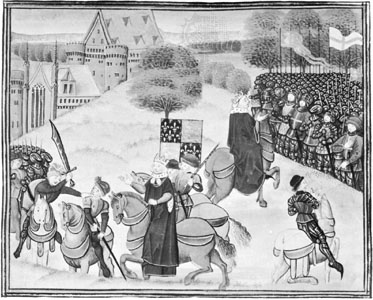Peasants' Revolt
English history
also called Wat Tyler's Rebellion
 (1381), first great popular rebellion in English history. Its immediate cause was the imposition of the unpopular poll tax of 1381, which brought to a head the economic discontent that had been growing since the middle of the century. The rebellion drew support from several sources and included well-to-do artisans and villeins as well as the destitute. Probably the main grievance of the agricultural labourers and urban working classes was the Statute of Labourers (1351), which attempted to fix maximum wages during the labour shortage following the Black Death.
(1381), first great popular rebellion in English history. Its immediate cause was the imposition of the unpopular poll tax of 1381, which brought to a head the economic discontent that had been growing since the middle of the century. The rebellion drew support from several sources and included well-to-do artisans and villeins as well as the destitute. Probably the main grievance of the agricultural labourers and urban working classes was the Statute of Labourers (1351), which attempted to fix maximum wages during the labour shortage following the Black Death.The uprising was centred in the southeastern counties and East Anglia, with minor disturbances in other areas. It began in Essex in May, taking the government of the young king Richard II by surprise. In June rebels from Essex and Kent marched toward London. On the 13th the Kentish men, under Wat Tyler (Tyler, Wat) (q.v.), entered London, where they massacred some Flemish merchants and razed the palace of the king's uncle, the unpopular John of Gaunt, Duke of Lancaster. The government was compelled to negotiate. On the 14th Richard met the men of Essex outside London at Mile End, where he promised cheap land, free trade, and the abolition of serfdom and forced labour. During the king's absence, the Kentish rebels in the city forced the surrender of the Tower of London; the chancellor, Archbishop Simon of Sudbury, and the treasurer, Sir Robert Hales, both of whom were held responsible for the poll tax, were beheaded.
The king met Tyler and the Kentishmen at Smithfield on the following day. Tyler was treacherously cut down in Richard's presence by the enraged mayor of London. The king, with great presence of mind, appealed to the rebels as their sovereign and, after promising reforms, persuaded them to disperse. The crisis in London was over, but in the provinces the rebellion reached its climax in the following weeks. It was finally ended when the rebels in East Anglia under John Litster were crushed by the militant bishop of Norwich, Henry le Despenser, on about June 25.
The rebellion lasted less than a month and failed completely as a social revolution. King Richard's promises at Mile End and Smithfield were promptly forgotten, and manorial discontent continued to find expression in local riots. The rebellion succeeded, however, as a protest against the taxation of poorer classes insofar as it prevented further levying of the poll tax.
- Al- Bāṭinah
- Al- Bīrah
- al- Bīrūnī
- al- Būṣīrī
- Alcaeus
- alcaic
- alcalde
- Alcalá, Calle de
- Alcalá de Guadaira
- Alcalá de Henares
- Alcalá Zamora, Niceto
- Alcamenes
- Alcamo
- Alcan Aluminium Limited
- Al Capone
- Al Capp
- Alcaraz carpet
- Alcatraz Island
- alcazar
- Alceu Amoroso Lima
- alchemy
- Alchevsk
- Alchian, Armen A.
- Alcibiades
- Alcidae